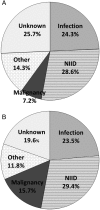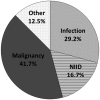Diagnostic workup for fever of unknown origin: a multicenter collaborative retrospective study
- PMID: 24362014
- PMCID: PMC3884594
- DOI: 10.1136/bmjopen-2013-003971
Diagnostic workup for fever of unknown origin: a multicenter collaborative retrospective study
Abstract
Objective: Fever of unknown origin (FUO) can be caused by many diseases, and varies depending on region and time period. Research on FUO in Japan has been limited to single medical institution or region, and no nationwide study has been conducted. We identified diseases that should be considered and useful diagnostic testing in patients with FUO.
Design: A nationwide retrospective study.
Setting: 17 hospitals affiliated with the Japanese Society of Hospital General Medicine.
Participants: This study included patients ≥18 years diagnosed with 'classical fever of unknown origin' (axillary temperature ≥38°C at least twice over a ≥3-week period without elucidation of a cause at three outpatient visits or during 3 days of hospitalisation) between January and December 2011.
Results: A total of 121 patients with FUO were enrolled. The median age was 59 years (range 19-94 years). Causative diseases were infectious disease in 28 patients (23.1%), non-infectious inflammatory disease in 37 (30.6%), malignancy in 13 (10.7%), other in 15 (12.4%) and unknown in 28 (23.1%). The median interval from fever onset to evaluation at each hospital was 28 days. The longest time required for diagnosis involved a case of familial Mediterranean fever. Tests performed included blood cultures in 86.8%, serum procalcitonin in 43.8% and positron emission tomography in 29.8% of patients.
Conclusions: With the widespread use of CT, FUO due to deep-seated abscess or solid tumour is decreasing markedly. Owing to the influence of the ageing population, polymyalgia rheumatica was the most frequent cause (9 patients). Four patients had FUO associated with HIV/AIDS, an important cause of FUO in Japan. In a relatively small number of cases, cause remained unclear. This may have been due to bias inherent in a retrospective study. This study identified diseases that should be considered in the differential diagnosis of FUO.
Keywords: INTERNAL MEDICINE.
Figures





Similar articles
-
Key diagnostic characteristics of fever of unknown origin in Japanese patients: a prospective multicentre study.BMJ Open. 2019 Nov 19;9(11):e032059. doi: 10.1136/bmjopen-2019-032059. BMJ Open. 2019. PMID: 31748308 Free PMC article.
-
Relationships between Causes of Fever of Unknown Origin and Inflammatory Markers: A Multicenter Collaborative Retrospective Study.Intern Med. 2015;54(16):1989-94. doi: 10.2169/internalmedicine.54.3313. Epub 2015 Aug 15. Intern Med. 2015. PMID: 26278289
-
Fever of unknown origin--diagnostic methods in a European developing country.Vojnosanit Pregl. 2016 Jun;73(6):553-8. doi: 10.2298/vsp140827050b. Vojnosanit Pregl. 2016. PMID: 27498447
-
Fever of unknown origin (FUO) revised.Wien Klin Wochenschr. 2016 Nov;128(21-22):796-801. doi: 10.1007/s00508-016-1083-9. Epub 2016 Sep 26. Wien Klin Wochenschr. 2016. PMID: 27670857 Free PMC article. Review.
-
The changing pattern of fever of unknown origin in the Republic of North Macedonia.Rom J Intern Med. 2019 Sep 1;57(3):248-253. doi: 10.2478/rjim-2019-0007. Rom J Intern Med. 2019. PMID: 30862765 Review.
Cited by
-
Retrospective analysis of 1,641 cases of classic fever of unknown origin.Ann Transl Med. 2020 Jun;8(11):690. doi: 10.21037/atm-20-3875. Ann Transl Med. 2020. PMID: 32617310 Free PMC article.
-
A Diagnostic Tool for Identification of Etiologies of Fever of Unknown Origin in Adult Patients.Curr Med Sci. 2019 Aug;39(4):589-596. doi: 10.1007/s11596-019-2078-3. Epub 2019 Jul 25. Curr Med Sci. 2019. PMID: 31346995
-
Recent trends in the distribution of causative diseases of fever of unknown origin.Wien Klin Wochenschr. 2017 Mar;129(5-6):201-207. doi: 10.1007/s00508-016-1159-6. Epub 2017 Jan 16. Wien Klin Wochenschr. 2017. PMID: 28093613
-
Fever of unknown origin.Clin Med (Lond). 2015 Jun;15(3):280-4. doi: 10.7861/clinmedicine.15-3-280. Clin Med (Lond). 2015. PMID: 26031980 Free PMC article.
-
Key diagnostic characteristics of fever of unknown origin in Japanese patients: a prospective multicentre study.BMJ Open. 2019 Nov 19;9(11):e032059. doi: 10.1136/bmjopen-2019-032059. BMJ Open. 2019. PMID: 31748308 Free PMC article.
References
-
- Alt HL, Barker MH. Fever of unknown origin. JAMA 1930;94:1457–61
-
- Petersdorf RG, Beeson PB. Fever of unexplained origin: report on 100 cases. Medicine (Baltimore) 1961;40:1–30 - PubMed
-
- de Kleijn EM, Vandenbroucke JP, van der Meer JW. Fever of unknown origin (FUO). I A. prospective multicenter study of 167 patients with FUO, using fixed epidemiologic entry criteria. The Netherlands FUO Study Group. Medicine (Baltimore) 1997;76:392–400 - PubMed
-
- Miller RF, Hingorami AD, Foley NM. Pyrexia of undetermined origin in patients with human immunodeficiency virus infection and AIDS. Int J STD AIDS 1996;7:170–5 - PubMed
-
- Zenone T. Fever of unknown origin in adults: evaluation of 144 cases in a non-university hospital. Scand J Infect Dis 2006;38:632–8 - PubMed
LinkOut - more resources
Full Text Sources
Other Literature Sources
